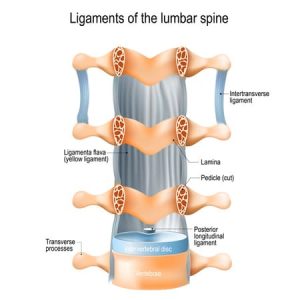What Is Spinal Ligament Thickening and What Causes It?
 Spinal ligament thickening, also known as ligamentum flavum hypertrophy, refers to the abnormal enlargement or thickening of the ligaments in the spine. The ligamentum flavum is a key spinal ligament that connects the vertebrae and provides stability to the spine.
Spinal ligament thickening, also known as ligamentum flavum hypertrophy, refers to the abnormal enlargement or thickening of the ligaments in the spine. The ligamentum flavum is a key spinal ligament that connects the vertebrae and provides stability to the spine.
When the spinal ligament thickens, it can lead to several issues, including:
- Spinal Stenosis: The thickened ligament can reduce the space within the spinal canal, compressing the spinal cord and nerves, leading to pain, numbness, and weakness, especially in the legs.
- Reduced Flexibility: The thickened ligament can decrease the flexibility and movement of the spine, contributing to stiffness and discomfort.
- Pain: The compression of nerves and the spinal cord can cause significant back pain, which may radiate to other areas of the body, such as the legs.
- Nerve Impingement: The thickened ligament can press on the nerves exiting the spinal column, leading to symptoms like tingling, numbness, and weakness in the extremities.
Spinal ligament thickening can occur due to a variety of factors. These are some common causes:
- Aging: As we age, the ligaments in the spine can lose their elasticity and become thicker. This is a common part of the degenerative changes that occur with aging.
- Degenerative Disc Disease: When the discs between the vertebrae start to degenerate, it can lead to changes in the spine’s structure, including thickening of the ligaments.
- Chronic Inflammation: Conditions that cause chronic inflammation, such as arthritis, can lead to thickening of the spinal ligaments as the body responds to ongoing inflammation.
- Spinal Stenosis: This is a condition where the spinal canal narrows, and it can be both a cause and an effect of ligament thickening. Thickened ligaments can contribute to narrowing, and the narrowing can cause ligaments to thicken as a compensatory response.
- Injury or Trauma: Past injuries or trauma to the spine can lead to scar tissue formation and subsequent thickening of the ligaments as part of the healing process.
- Genetic Factors: Some individuals may be genetically predisposed to developing thicker ligaments.
- Repetitive Stress: Activities that put repetitive stress on the spine can cause ligaments to thicken over time. This includes occupations or sports that involve heavy lifting or repetitive bending and twisting.
- Obesity: Excess weight can put additional strain on the spine, potentially leading to changes in the ligaments, including thickening.
If you have spinal ligament thickening, you might notice a variety of symptoms, depending on the severity and location of the thickening.
Common symptoms include:
- Back Pain: Persistent or intermittent pain in the lower back or neck, depending on where the thickening occurs.
- Stiffness: Reduced flexibility and stiffness in the spine, making it difficult to bend or twist.
- Numbness or Tingling: Sensations of numbness, tingling, or a “pins and needles” feeling, particularly in the legs, feet, arms, or hands.
- Weakness: Muscle weakness, especially in the legs or arms, which may affect your ability to walk or perform daily activities.
- Sciatica: Pain that radiates from the lower back down one or both legs, often described as a sharp or burning sensation.
- Balance Problems: Difficulty maintaining balance, which may lead to unsteadiness or falls.
- Loss of Bladder or Bowel Control: In severe cases, you might experience incontinence or difficulty controlling bladder or bowel functions, indicating possible nerve compression.
- Pain Worsening with Activity: Symptoms that worsen with standing, walking, or other physical activities and may improve with rest or bending forward.
If you experience any of these symptoms, especially if they interfere with your daily activities or worsen over time, it’s important to seek medical evaluation. Early diagnosis and treatment can help manage the symptoms and prevent further complications.
Diagnosis typically involves imaging studies such as MRI or CT scans to assess the extent of ligament thickening and its impact on the spinal canal and nerves.. Treatment options will depend on the severity of the condition and the symptoms being experienced. And may include physical therapy, medications, injections, and, in severe cases, surgery to relieve the compression of the spinal cord and nerves.
